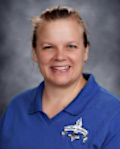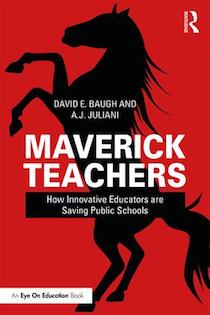A Look at Some Teachers Working Outside the Box
Maverick Teachers: How Innovative Educators are Saving Public Schools
By David E. Baugh and A.J. Juliani
(Routledge/Eye On Education, 2019 – Learn more)

There are many different types of teachers in the education field. The spectrum can range from the most traditional teacher to educators who truly embrace teaching outside of the box. This book highlights a selection of nontraditional teachers who are comfortable with change and their non-traditional methods of teaching.

Then I reflected on the content again and realized this book does not address the subtitle claim, “how innovative educators are saving public schools.” If you are a teacher wanting to make the leap from the traditional side, this book lacks the details of how to make that change. It also lacks the data to motivate and further support teachers to take that leap.
I appreciated the variety of teaching positions that were highlighted throughout the book, from Kindergarten and ELL to Math, ELA, STEM, and many other grade levels and subjects. I found the importance of space layout, working the room, building trust and relationships in students, and also how listening to and using students’ interests, were all themes that resonated throughout each chapter and with each educator. The highlighted educators all find great value in building relationships, connecting with students and making them feel valued and a part of their learning, not just test subjects.
As much as I liked the inspirational stories, however, I found Maverick Teachers lacked an explanation of how these innovating teachers are “saving public schools.” There are no details of how these teachers put their innovative ways into action, where they got funding, if they got pushback or resistance from colleagues or teachers, or if and how they spread their innovation.
So how do we get there?
Like me, other readers might desire a deeper look behind the scenes, with more specifics about lessons, techniques and strategies that might lead to “saving public schools.” Additional data (really, any data) to support how these educators are saving their schools (not just the kids in their classes) would be appreciated as well. There’s no qualitative or quantitative information provided that describes how the schools were before these educators applied their outside-the-box methods and what substantive positive changes occurred after they began innovating.
There is sometimes a vague mention of how a school was previously running, or how the teacher used to teach, compared to what they focus on now, but again it is lacking the significant details that might make this book helpful to others. Indeed, there is no mention of what other colleagues think of these innovative teachers (except the administrators, who all seem to be very supportive). “Saving schools” requires schoolwide impact and that’s a story that’s missing here.
In reading Maverick Teachers, I felt like I was reading a Chicken Soup for the Non-Traditional Teacher. The inspirational stories feature teachers whose work is easy to admire. I just wish the book was as much about the professional growth of the reader as it was about the mavericks’ accomplishments – that it contained more details and some data to support teaching methods we might want to emulate.
Any teacher that teaches “outside the box” will feel connected with these teachers, and there are examples for administrators in how to support them. As I read the book a second time, I began to pick out similar traits among the profiled educators and good general teaching strategies that any teacher should be encouraged to incorporate as best as they can. But in the end, I was disappointed in not finding more pieces of a framework for whole school change.
Abby Bateman, a 7th Grade math teacher in Saint Croix Falls, WI, has been teaching for 18 years and has earned a Master’s degree in mathematics education. She is also a teacher of computer science (coding) and STEM and is an interventionist teacher. She truly enjoys teaching middle school students; they keep her alert, inventive and on her toes. When she is not teaching, she enjoys spending time with family (her own middle school-aged children) and knitting.






























